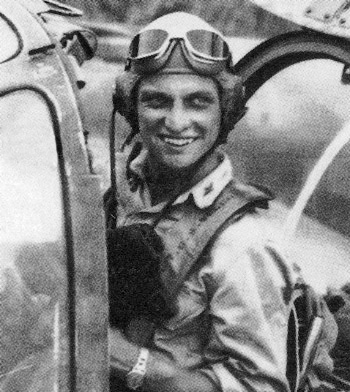George Welch was born on May 10, 1918, in Wilmington, Delaware. He entered the Aviation Cadet Program of the U.S. Army Air Corps in October 1939, and was commissioned a 2d Lt and awarded his pilot wings at Kelly Field, Texas, on October 4, 1940. His first assignment was as a P-40 Warhawk pilot with the 55th Pursuit Squadron of the 20th Pursuit Group at Hamilton Field, California, from October 1940 to February 1941, followed by service with the 47th Pursuit Squadron of the 15th Pursuit Group at Wheeler Field, Hawaii, from February 1941 to January 1942. During this time, Lt Welch was able to make it into the air during the Japanese attack on Pearl Harbor and was credited with shooting down 4 enemy aircraft in aerial combat. After attending War Bond tours in the U.S., he returned to combat with the 36th Fighter Squadron of the 8th Fighter Group in New Guinea, where he destroyed 3 more enemy aircraft while flying the P-39 Airacobra. Capt Welch transferred to the 80th Fighter Squadron, also under the 8th Fighter Group, in May 1943, and was credited with destroying another 9 enemy aircraft in aerial combat, plus 1 probable, while flying the P-38 Lightning between June and September 1943. This gave him a total of 16 enemy aircraft destroyed in the air and 1 probable during World War II. Welch was then sent to Australia to recover from malaria, and then returned to the U.S. where he served developing fighter tactics and performed War Bond tours until he resigned his commission and joined North American Aviation as a test pilot in June 1944. During the last year of the war, George test flew variations of the P-51 Mustang and he made the first flight of the XP-82 Twin Mustang in 1945. He also served as the chief test pilot on the XP-86 Sabre project, taking that aircraft into the air for its first flight on October 1, 1947, where he exceeded the speed of sound in a shallow dive. Welch later took the first prototype YF-100 Super Sabre supersonic on its maiden flight on May 25, 1953, but was later killed while testing an F-100A on October 12, 1954. During the Korean War, Welch also flew combat as an instructor on the F-86 Sabre, where he destroyed as many as 6 enemy fighters, but none of these were ever officially credited to him. George Welch was buried at Arlington National Cemetery.
His Distinguished Service Cross Citation reads:
The President of the United States of America, authorized by Act of Congress, July 9, 1918, takes pleasure in presenting the Distinguished Service Cross to Second Lieutenant (Air Corps) George Schwartz Welch, United States Army Air Forces, for extraordinary heroism in connection with military operations against an armed enemy while serving as Pilot of a P-40 Fighter Airplane in the 47th Pursuit Squadron, 18th Pursuit Group, HAWAIIAN Air Force, in action over the Island of Oahu, Territory of Hawaii and waters adjacent thereto, on 7 December 1941. When surprised by a heavy air attack by Japanese forces on Wheeler Field and vicinity at approximately 8 a.m., Lieutenant Welch left Wheeler and proceeded by car, under fire, to Haleiwa Landing Field, approximately ten miles distance, where his squadron's planes were stationed. Immediately, on his own initiative, he took off for the purpose of attacking invading forces, without first obtaining information as to number or type of Japanese in the attacking force, and proceeded to his initial point over Barbers Point. At time of take off he was armed only with thirty-caliber machine guns. Upon arrival over Barbers Point, he observed a formation of approximately twelve planes over Ewa, about 100 feet below and ten miles away. Accompanied by only one other pursuit ship, he immediately attacked this enemy formation, shooting down an enemy dive bomber with one burst from three .30-caliber guns. At this point one .30 gun jammed. While engaged in this combat, his plane was hit by an incendiary bullet which passed through the baggage compartment just in rear of his seat. He climbed above the clouds, checked his plane, returned to the attack over Barbers Point and immediately attacked a Japanese plane running out to sea, which he shot down, the plane falling in the ocean. No more enemy planes in sight, he proceeded to Wheeler to refuel and replenish ammunition. Refueling and reloading completed but before repairing guns, a second wave of about fifteen enemy planes approached low over Wheeler. Three came at him and he immediately took off, headed straight into the attack and went to the assistance of a brother officer being attacked from the rear. This enemy plane burst into flames and crashed halfway between Wahiawa and Haleiwa. During this combat his plane was struck by three bullets from the rear gun of the ship he was attacking, one striking his motor, one the propeller and one the cowling. This attack wave having disappeared he returned to the vicinity of Ewa and found one enemy plane proceeding seaward, which he pursued and shot down about five miles off shore, immediately thereafter returning to his station at Haleiwa Landing Field. Lieutenant Welch's initiative, presence of mind, coolness under fire against overwhelming odds in his first battle, expert maneuvering of his plane, and determined action contributed to a large extent toward driving off this sudden unexpected enemy air attack. Second Lieutenant Welch's unquestionable valor in aerial combat is in keeping with the highest traditions of the military service and reflects great credit upon himself, the Hawaiian Air Force, and the United States Army Air Forces.
|



